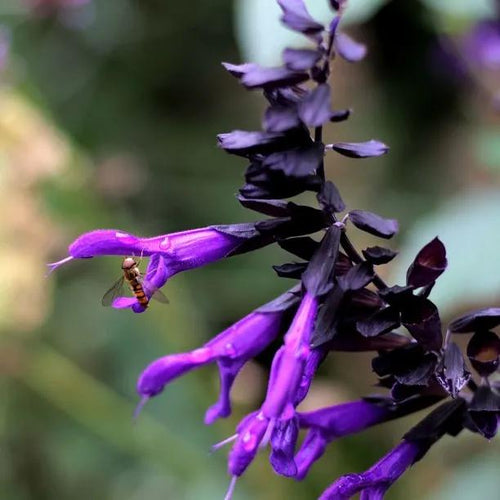Amistad Sage Plants
Amistad Sage (Sage is just the English for Salvia) has vivid purple flowers that really pop against the almost black stems. This plant is a must for anyone who likes impromptu mini-vase arrangements, as Amistad has a huge flowering period; from at least June to October. In ideal conditions, May to November is not unusual. The leaves are a bit greener than a lot of other sages. Good for bees. To 1m x 50cm
Browse our range of Salvia varieties or all of our perennial plants.
Features
- Colour: Vivid purple flowers, almost black stems
- Flowering: June to October / November
- Foliage: Deciduous, light green
- Height: 1m x 50cm
- Position: Sunny, sheltered
- Any well-drained soil, likes chalk
- RHS Plants for Pollinators
- RHS Award of Garden Merit
Growing Amistad Sage
Salvias need close to full sun, and will grow near the coast in exposed locations. They're fully hardy, although their flowering season will be shortened somewhat in cold and windy places. They're happy on chalk, and like a light, well-drained but moist soil enriched with humus that doesn't remain wet in winter, so heavy clay is a bit of a no-no.
All Salvias are ideally suited to a Mediterranean or gravel garden, and they are also great in large containers. Established plants are drought-resistant, but fairly consistent moisture in summer periods ensures they flower really well.
Deadhead promptly to get the most from the flowering season. Leave the withered foliage on the plants overwinter for protection, and trim them, after the last spring frost, right down to the new growth at ground level
Mulch lightly every year or two, ideally after a heavy spring rain and when the soil has warmed up. Salvias don't need much fertility, so a little help goes a long way.
Garden Design Ideas
Salvia Armistad is brilliant for adding rich colour and form to the back of a border. Combine it with Dahlia Totally Tangerine or Sylvia for a wow factor colour scheme. For a quieter palette, try the delicate Rosa The Simple Life or the more bouncy It's a Wonderful Life, which is inspiring simply by virtue of its name.
History & Trivia
Armistad was originally found in an Argentinian garden by Professor Ronaldo Uria at the Buenos Aires School of Agriculture. In Spanish, the name means friendship (it is sometimes sold as Friendship Sage in other English-speaking countries), and Professor Uria made some effort to distribute free samples of it to botanical friends around the world so that it could be both studied and appreciated by everyone!
It is probably a variety of Salvia guaranitica, but at the time of writing, we don't think that is officially confirmed.








 Secure, One-Tap Checkout
Secure, One-Tap Checkout
 Hand Picked, Delivered to Your Door!
Hand Picked, Delivered to Your Door! 1 Year Bareroot Guarantee
1 Year Bareroot Guarantee